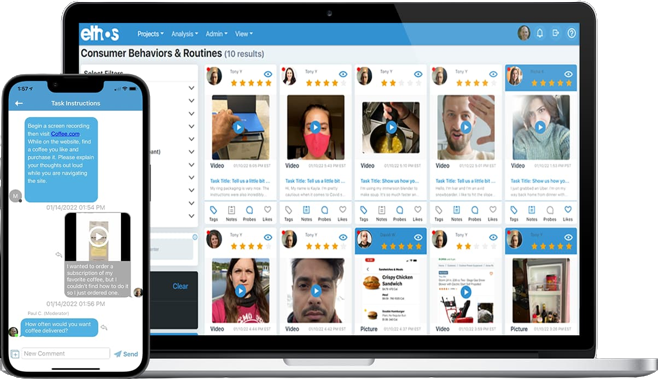Introduction
Ethnography is a methodology that enables researchers to gain contextual insights into how customers use products and services in their daily lives. In recent years technology has paved the way for digital ethnography, which allows researchers to conduct ethnography remotely through a purpose-built platform (usually made up of a mobile app and dashboard). Digital ethnography provides several advantages over traditional, in-person ethnography. To name a few, it allows for larger sample sizes with faster turnaround times, simplifies analysis, and lowers costs.
As the importance of delivering exceptional user experiences continues to be recognized across industries, more and more companies are investing in user research to gain deeper insights into their customers’ needs and preferences. The State of User Research 2022 Report found that 94% of companies now have at least one user experience researcher on their team, and researchers are reporting greater internal buy-in of their work. This has led to the emergence of specialized research platforms that streamline and optimize traditionally labor-intensive methodologies.
Among the various digital ethnography tools available on the market, we have identified three that are particularly noteworthy which be the focus of this article.
Things to consider when selecting a digital ethnography tool
Finding the right digital ethnography tool for your project requires careful consideration of your research goals and the functionality each platform offers. To help you make an informed decision, consider the following questions:
- How much support will you need with study design and project management?
- Who is your target audience? And how much support will they need with an app-based study?
- What is your plan for the analysis of the results? What do you expect from the platform in terms of analysis capability?
- Which languages will you need the tool to support?
- Should this platform be specialized for only ethnography, or will you need it to offer use cases for a broader range of qualitative research?
- What types of programs should it integrate with?
Before making a decision, schedule demos with your top choices. Demos are a crucial step in the decision-making process as they allow you to gain first-hand experience and you can ask questions to ensure the tool meets your needs.
3 digital ethnography tools to consider

EthOS
Best for: flexibility and in-depth insights.
EthOS is a digital ethnography tool made up of two pieces. A participant-facing app that’s used for data collection and a web-based dashboard that facilitates analysis.
EthOS was created by an ethnographer, so it replicates in-person ethnography better than other options on the market. The goal of ethnography is to capture natural habits and behaviors, so the EthOS app was designed to mimic how people communicate today. It has a text-message-like interface that participants feel comfortable with, making the collection of pictures, videos, and text second nature. This leads to more authentic and open feedback from participants which ultimately results in richer insights.
From the perspective of the researcher, the platform has many features that make data collection and analysis quick and easy. There are a variety of task types to fit all data collection needs, including video, text, mobile screen recordings, and survey questions. Each of these tasks is customizable, giving the researcher control over what data gets collected.
When the time comes to analyze your results, the platform supports an easy-to-use coding system. Just highlight text within video transcriptions and probing conversations to theme your data. Researchers can also make use of built-in sentiment analysis to gain a quick overview of their results and identify areas of interest. Once analysis is complete, research findings can be shared with stakeholders through video reels. The EthOS video reel editor allows you to stitch together pictures, videos, and quotes from the study that support your findings.
Indeemo
Best for: a social media-style study.
Indeemo is also a two-part platform with a mobile app and researcher dashboard available on desktop. Indeemo is set up to feel like a social media app, similar to Instagram.
Indeemo allows researchers to capture digital and real-world experiences through a variety of data collection methods, making mapping the customer journey simple and clear. They offer a variety of task types, and support methodologies like diary studies and in-home usage tests.
This platform allows for multiple studies to run concurrently and is available in over 20 languages, making it ideal for global studies. When analyzing the data, they offer automated transcriptions, coding, and other tools that make uncovering insights a stress-free process.
Field Notes
Best for: your first digital ethnography project.
Field Notes is the most basic of the three tools. It allows participants to upload self-shot videos from anywhere in the world. The platform offers full customization and control of the tasks set by moderators. They boast a presence in 10 countries with a localized platform in 9 languages.
The platform has been around for 7 years, giving them expertise in high-quality video data capture. While their tasks are fully customizable, they don’t offer any automated analysis, meaning you would have to deploy an alternative tool to gain insights from the videos. With that said, the platform is free to use on the app store, making it a great starter product for collecting user experience insights.
Final Thoughts
The digital ethnography tool you choose can make or break your study. Therefore, it’s imperative to take a thoughtful and deliberate approach while selecting one. To begin your search, it’s essential to ask yourself what features you need and what you want out of the study. Ultimately, the right decision hinges on your project’s specific requirements and goals. Hence, it’s crucial to conduct thorough research and view demos to make an informed decision.

